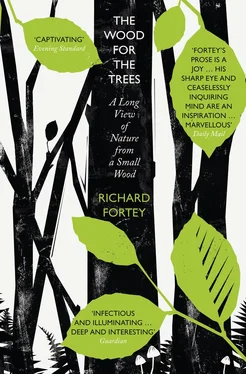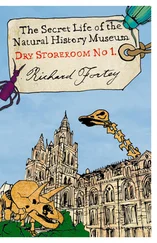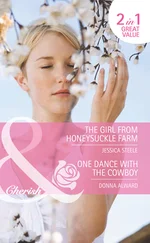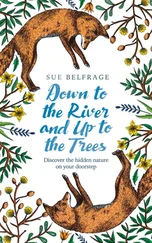Cousin John is felling a beech tree that is leaning dangerously over the public footpath. Accidents in woods caused by falling branches are very rare – most people have the sense to stay out of the woods during tornados. But beeches sometimes shed a whole branch just for the hell of it: these are called ‘widow-makers’ (they never fall on girls). We cannot have that happen to a passing dog-walker. John starts with a saw on a long pole to trim off the side branches. One of them almost touches the ground, such is the curve on the tree over the path. He can reach more branches with a chainsaw borne aloft on a staff; then, with a bigger chainsaw, the main action. The saw makes a raucous, grating racket, with something of the unforgiving persistence of the dentist’s drill about it. John is a professional, so he sports massive earmuffs and mighty gauntlets. Bystanders are reduced to making encouraging gestures and gurning amiably.
There is only one way for the tree to fall, but there is a skill to making the cuts so that it does not spring any surprises. The poor beech groans, crackles like a fusillade of fireworks, and then it is down, just like that. With a girth of three feet there is a lot of firewood to be mined. Despite its lopsidedness the tree is still very much alive, so now on the ground its branches stick up all stiff and unnatural, decked in new leaves that flutter in the breeze for the last time. They will be limp by next morning. The centre of the trunk proves to be quite rotten – black, and hollowing out. The tree would have cracked eventually, so it was as well we took it down. The fungal damage extends further up the trunk until it is visible only as a curious kind of dark hieroglyph in the centre of the log. John cuts lengths from the upper part of the tree that will be taken away in his van to be sawn into rounds, then split into logs for next year’s open fires at home. The fat end of the tree is winched into a position where we can use it as a rustic seat in future and study its slow decay. The brash is carried into the wood to rot away and return to the soil. Who would believe that one, not particularly large, tree could generate so much work?
Falling beech branches have crushed a few bluebells, but no matter, they are already showing signs of decline. The great sea of blooms has deepened to an azure colour, and still looks unbroken from afar, but the lower flowers on the spikes are already blousy and fading. Their dark-green blades of leaves have lost the vigour of their youth, and have started to become flaccid and unenthusiastic. But as one flower starts to fade, another prospers.
Patches of ground near the bluebells are covered with neatly tiered rosettes of lance-shaped leaves. A cluster of tiny white flowers crowns each tier; this plant is the perennial sweet woodruff ( Galium odoratum ), no taller than the bluebell. Each flower in the cluster has only four wee petals; under my lens the edges of the leaves can be seen to be lined with minute prickles that can be felt by gingerly stroking a finger along their margins – usually eight delicate leaves to a whorl. As for the sweetness implied in both the common and the Latin name, this little plant has a fragrance more persuasive than that of any bluebell. Its sweetness grows as the woodruff is dried – which it does readily. I placed a bunch in a warm airing cupboard and it was preserved in a day. Dried woodruff was once slipped between the sheets to sweeten bedding, so the sleeper might dream of woods in spring. The scent of new-mown hay is the same chemical agent (coumarin) as in woodruff, but only if that hay has sweet vernal grass as one of its components. Sweet woodruff is used to flavour traditional springtime drinks and sweets in Germany, though its German name of Waldmeister (‘master of the woods’) seems too assertive for such a refined little plant. My son thought to try it as a ‘botanical’ to flavour gin; there has been a revival in boutique spirits, and he wants to be ahead of the Zeitgeist . Although juniper berries are the traditional flavoring for gin, all kinds of refinements are possible by steeping other herbs and spices in the spirit. Experimental Batch Number One was rather overpowering, but Experimental Batch Number Two turned out to be delicious. It was presented with a tasteful label featuring the wood in spring. Grim’s Dyke Gin may yet feature in some future genre market.
Bluebell and sweet woodruff are specialists. Not every bulb or herb can thrive in our beech woodland. Timing is all. These plants have to steal as much light as they can before the canopy shuts off the sunshine. There is really no option but to flower in spring. They join the dog violet and the lesser celandine in the early shift. Wood melick, which makes something approaching a field of lively green over parts of the wood in May, will produce its nodding rod of single flowers and then fade before summer is over. The bluebells’ burst of photosynthetic activity is done even before the beech leaves mature, and the energy the plants have gained during their brief but glorious exuberance is stored in the bulb. Job done, everything above ground withers away. The lesser celandine’s 3pretty, heart-shaped leaves also enjoy but a brief existence; they soon turn yellow and shrivel. They too sequester energy in little cream-coloured, bulb-like storehouses that linger in a somewhat scrotal cluster below the ground through most of the year. I have seen similar-looking bulblets form at leaf junctions, any one of which might produce a new plant next season. The leaves of sweet woodruff and violets linger on, a little dowdily, after flowering, but the woodruff has a strong root network that can survive a major drought unharmed. I add two more pleasing spring flowers discovered from snuffling around in the wood: a discreet purple-flowered wood speedwell, Veronica montana , modestly creeping along a pathside where there is a little more light, and a pretty buttercup, goldilocks ( Ranunculus auricomus ), with apparently much the same requirements. Both have the kind of understated beauty that rewards a little botanical nous.
Our slowly spreading English bluebell is a marker for ancient woodlands. Stately wood spurge ( Euphorbia amygdaloides ) tells the same story, and I have found it in four places. It almost makes a small shrub. Its young, leafy shoots are a lovely coppery hue and slightly pendent, contrasting well with the flowering heads, which are a lively green. All spurges have peculiar flowers, unlike those of any other plant. They have none of the usual paraphernalia: no petals or sepals, and the reproductive parts are reduced to the minimum. What could be mistaken for petals are actually yellow-green leafy bracts that form a kind of cup around the minimalist sexual business. A cluster of these distinctive structures makes the flower head. Unlike lesser celandines and bluebells, the spurge plant stays on in the wood, gradually losing its fine vernal contrasts, and fading with dignity. I have seen spurge species thriving in deserts looking just like cacti, and others creeping on seashores, and yet more growing far too vigorously in my vegetable patch, so it is scarcely a surprise to find one species that likes to live in old Chiltern beech woods. All spurges carry a horrible, poisonous white sap that seeps out if a leaf or stem is broken. Once I accidentally rubbed a minute amount of the milk into my eye and danced around for two hours in excruciating agony, weeping profusely. I cannot recall such a painful reaction since they closed my favourite Chiltern pub (the Dog and Duck).
Men of letters
Writers are not a rare species. They seem to crop up everywhere, rather like spurges, although some are less poisonous. I confess that at first I thought I would have my patch of Chiltern Hills beech woods to myself. I was wrong. Over the brow of the ridge behind Lambridge Wood Barn, in the village of Lower Assendon, and just beyond the Fair Mile leading out of Henley-on-Thames in the Oxford direction, a small Tudor cottage decked in oak beams was home for several decades to a famous writer: Cecil Roberts. In the 1930s Roberts published a series of three books centred on Pilgrim Cottage: Gone Rustic , Gone Rambling and Gone Afield . I now have them all in hardback, though had I not bought Grim’s Dyke Wood I would probably never have heard of this particular author. Gone Rustic was reprinted at least six times: it was a bestseller. All the books are charming, gossipy, name-dropping confections about life in a kind of idealised Rustic. Beneath the dustjackets they have bas-relief covers with cottagey timber framing built in. Roberts’s is the same world as that in which Hercule Poirot joined genial house parties in small stately homes only to find His Lordship dead in the drawing room. It has an exact fictional match in E.F. Benson’s Mapp and Lucia novels, set in a genteel part of Sussex where private incomes would pay for housekeepers and cooks, and the protagonists could concentrate on painting watercolours and choosing chrysanthemum varieties. Working-class country folk tended to have only colourful walk-on parts.
Читать дальше












